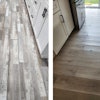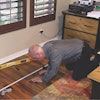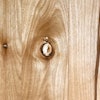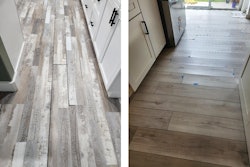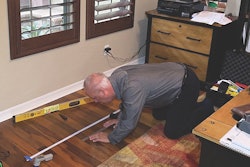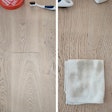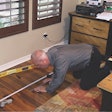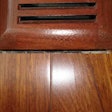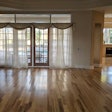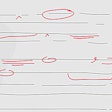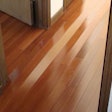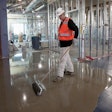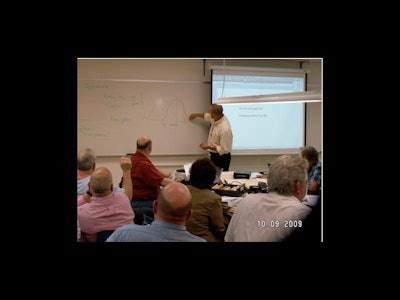
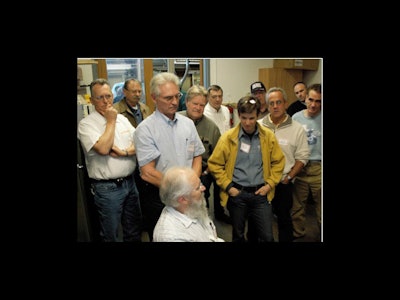
What you are about to read was written by an addict. In a national publication, I am about to reveal a deep, dark secret about myself: I am an educational junkie. Part of the recovery process is to fully admit when you have an addiction. I admit it.
However, I am not alone! There is a small group of inspectors, installers, manufacturers and retailers who love the flooring business. We love to learn. We are not in denial; we fully embrace our addiction. Since you are reading this publication to learn, you also might have the same condition.
Years ago, I was feeling inadequate as an inspector. I hated that feeling of not being able to explain to my clients what I was seeing. I felt like a con man each time I cashed a check, knowing my report was not up to my standards, because I just did not know.
Why did one wood floor cup and another did not? Why did this wood check, but, in another room, the wood that had been installed much earlier didn't? Why is there wood flooring gapping near Charleston, S.C.? Gaps? In Charleston? Unheard of, but I was seeing those gaps and many more issues that led me to feel I needed much more knowledge to be a good inspector.
Inspectors, as a group, usually fall into two categories: those who already know it all (inject sarcasm) and those who openly admit they do not. I do not know it all. Inspectors, have you ever written a report to find out later, being insufferably embarrassed, you were so wrong that even the "other side" felt sorry and embarrassed for you? If you answer no, you are in denial. If yes, then you have been motivated to never let that happen to you again. I have had such life lessons. Let me explain.
I was commissioned by a manufacturer to inspect an engineered wood floor glued to a concrete slab. The issue was severe face-checking. I reported the industry line: based on my one time/date relative humidity (RH) measurement, it was low RH causing the problem. The consumers were upset. They were fine people.
So, I started thinking, and that is always a dangerous path for flooring inspectors. I went on the Internet. I found a site with documented weather history for that area. I saw that during that week I did the inspection, the RH levels changed each day. What's more, I found they also changed during the day. At midnight during that week of my inspection, RH was as high as 80% but dropped to the 25% to 35% range during the day. Now I wanted to learn how this could happen, and how could checking be blamed on dry conditions when the RH levels changed so drastically during a 24 hour period? I had, by being ignorant, caused harm to good people. If it was not the environment, then, what was it.
To start my wood education beyond my work history as an installer, first I went to the old NOFMA/NWFA installation school. I learned a lot. I bought books, looked up research papers by wood scientists and, frankly, started pestering good wood people. Later, I attended inspector courses from both organizations, learning a lot. But still, I was not satisfied. The science was not there.
During the installation school, I met Howard Brickman. He freely gave his help teaching me how damn ignorant I had been. I am not one to be ashamed to say when I have been ignorant. Several months and many telephone calls later, Howard agreed to do a wood inspection course for inspectors. Howard's first class was in Dalton, Ga. My addiction now was beyond my control.
I started looking around for more people to teach me. It took being embarrassed again by someone: A wood laboratory had found I was wrong on a report, again. So, I learn, there are wood laboratories? That can test and examine wood? Then I learned about the Hodges Wood Laboratory at North Carolina State University. I toured the lab with Dr. Tony LaPasha and he explained the testing work that he was conducting. Later I met Dr. Joe Denig and Dr. Phil Mitchell. The four of us sat down and had a roundtable discussion on some of the problems I had seen in the field. An idea began to formulate in my head about how to involve these professionals and those in similar fields to teach technical updates to wood flooring inspectors. The idea was spurred by my impression that they were excited about teaching wood technology and are impartial stakeholders in this area.
That's how the first wood flooring class taught and geared specifically to inspectors and other wood flooring professionals at a university began. The subject was Engineered Wood Science. Since then classes have included Wood Identification, taught by Dr. Elisabeth Wheeler and Dr. Alex Wiedenhoeft (Dr. Wheeler is a retired professor from NCSU and Dr. Wiedenhoeft is the chief Wood Identification Scientist at the USDA's Forest Products Laboratory); Advanced Engineered Wood Science for wood inspectors; and Wood Characteristics and Defects, with emphasis on moisture and wood, taught by Dr. Mitchell and Dr. Denig. The day before the Advanced class, there was an Introduction to Concrete Class taught by Dr. Roberto Nunez, who is a concrete engineer.
The goal of these classes is to increase the knowledge of the inspector in wood science and wood behavior so that the inspectors could do a better job of collecting data and interpreting the results. The classes were not designed to teach how to inspect.
Another exciting aspect of the classes is that it gives the participating inspectors time to interact with each other during class and after-hours. This scenario provides an opportunity to ask other inspectors their experience when faced with a variety of different problems. The faculty from NCSU seem to enjoy the classes as much as the flooring inspectors attending. The inspectors bring ideas and problems that stimulate the instructors and provide topics for future research.
The demand for seats in the classes has increased to the point that many people are being turned away. The next class will be in Charleston, S.C., in early fall; topics will be: new construction techniques, moisture control, building envelope science, and how to relate all those topics to flooring. Three of the professors will be teaching again, but this one is going to be special: My friend Howard Brickman will do a one-day, hands-on, data collection class to teach inspectors the correct method to gather data when inspecting wood flooring. If you are an addict just like me, I urge you to contact me and join us for more lifelong learning.
 A professor explaining a drying schedule for kiln-drying, hopefully to prevent warping and checking of the wood
A professor explaining a drying schedule for kiln-drying, hopefully to prevent warping and checking of the wood
 In the Wood ID course, former NOFMA Technical Director Howard Brickman is listening to Dr. Elisabeth Wheeler and Dr. Alex Wiedenhoeft. Not in his seat to Howard's left is another former NOFMA director, Mickey Moore. Now, that was a class: two former NOFMA technical directors sharing laughs and contributing!
In the Wood ID course, former NOFMA Technical Director Howard Brickman is listening to Dr. Elisabeth Wheeler and Dr. Alex Wiedenhoeft. Not in his seat to Howard's left is another former NOFMA director, Mickey Moore. Now, that was a class: two former NOFMA technical directors sharing laughs and contributing!
 When drying hardwood, the kiln operator will cut the samples in this configuration to determine if they are fully 'condition'. If the wood closes or spreads apart, the wood is not condition.
When drying hardwood, the kiln operator will cut the samples in this configuration to determine if they are fully 'condition'. If the wood closes or spreads apart, the wood is not condition.
 A PowerPoint presentation to kiln-dry students showing the computer technology that the new kilns have in their systems.
A PowerPoint presentation to kiln-dry students showing the computer technology that the new kilns have in their systems.
 More new kiln technology.
More new kiln technology.
 Roger Gerber is about to receive his certificate at graduation day for the first class.
Roger Gerber is about to receive his certificate at graduation day for the first class.
 Dr. Lapasha is explains how standards are correctly applied and what the standards tell us about a product. Standards and industry tests may be subjective. Wood is subjective.
Dr. Lapasha is explains how standards are correctly applied and what the standards tell us about a product. Standards and industry tests may be subjective. Wood is subjective.
 Dr. Mitchell, a guiding force behind these classes, reacts to a statement from an inspector. Dr. Mitchell has adopted wood flooring inspectors and the wood flooring industry.
Dr. Mitchell, a guiding force behind these classes, reacts to a statement from an inspector. Dr. Mitchell has adopted wood flooring inspectors and the wood flooring industry.
 Dr. Denig explains the forces that come into play from unbalanced construction.
Dr. Denig explains the forces that come into play from unbalanced construction.














